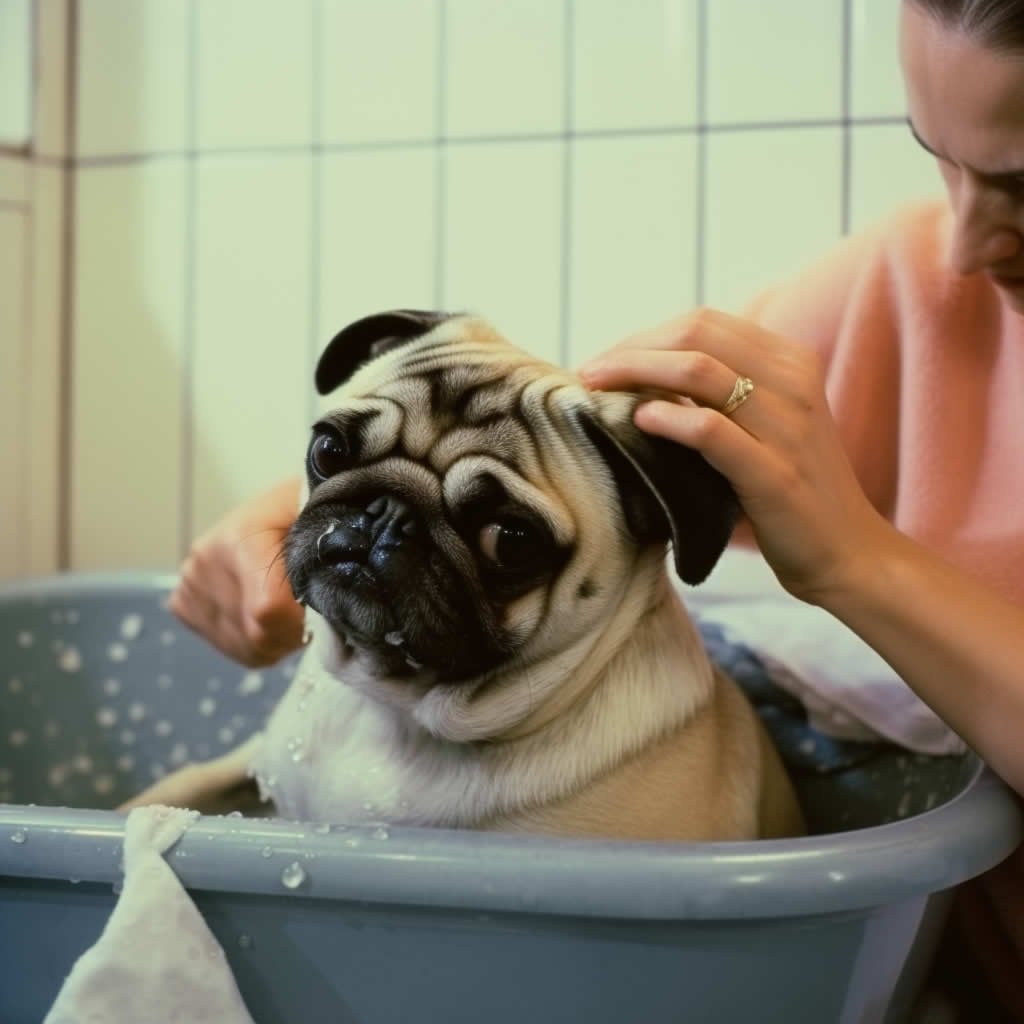How Often To Bathe My Pug?
Introduction
No dog owner can resist the adorable charm of a pug, but with great cuteness comes responsibility – like maintaining their hygiene. If you’ve recently welcomed one of these wrinkly bundles of joy into your life or are considering doing so, you may be wondering how often to bathe them.
Fortunately, pugs are relatively low-maintenance compared to other breeds and finding the right bathing routine is essential for keeping them healthy and happy.

Table of Contents
- Introduction
- How Often Should You Bathe Your Pug?
- Tips For Bathing Your Pug
- Conclusion
- Frequently Asked Questions
Key Takeaways
- The frequency of bathing your pug should be every 2 to 6 months, depending on their lifestyle and skin condition. Overbathing can lead to dry skin, while not doing it enough will make them smelly and unclean.
- Consider your pug’s lifestyle when determining the optimal bathing frequency. If they spend most of their time indoors, you may be able to extend the time between baths slightly. However, if they love exploring the outdoors or playing in mud puddles, you’ll likely need to bathe them more frequently.
- Always observe your pug’s behaviour after each bath and adjust accordingly based on their specific needs. Use a Pug-friendly shampoo that is gentle on their sensitive skin and be mindful of water temperature during bath time. Preparing a safe and comfortable space for your furry friend is also essential for successful bath times together.
How Often Should You Bathe Your Pug?
When it comes to bathing your pug, it’s important to find a balance between maintaining their hygiene and avoiding overbathing that may result in dry skin or allergies.
Avoid Overbathing
As a pug parent, it’s essential to strike the right balance when bathing your furry friend. Overbathing can cause skin irritation and dryness, which could make your adorable pug uncomfortable or even develop potential health issues.
For instance, while my neighbour bathed her pug every week in hopes of maintaining perfect cleanliness, she soon realised that this regiment was doing more harm than good. Her pug started experiencing dry skin and constant itching due to the removal of natural oils from its coat.
Consider Your Pug’s Lifestyle
Taking your Pug’s lifestyle into account is crucial when determining how often to bathe them. If your furry friend spends a majority of their time indoors, lounging on the couch, and engaging in low-impact activities, you may be able to extend the time between baths slightly.
For example, let’s say I take my Pug for daily walks around the neighbourhood but occasionally bring him along for weekend hikes or trips to the dog park. In this case, keeping up with our regular three-week bathing schedule should suffice most of the time.
However, after a particularly messy outdoor adventure involving muddy trails or sandy beaches (yes – pugs do love romping on beaches!), I would give him an additional bath right afterward to ensure his coat stays clean and healthy.
Observe Your Pug’s Skin Condition
One crucial aspect of determining how often to bathe my pug is to pay close attention to their skin condition. Just like us humans, our furry friends can also experience skin issues that need special care.
For instance, if you notice any redness, inflammation, or excessive itching, it might be a sign that your pug is suffering from allergies or infections.
Regularly examining your pug’s body during petting sessions will help ensure you’re aware of any changes in their skin health.
Remember that observing your beloved pug’s overall well-being goes beyond counting down days between baths – stay attentive to unexpected changes or potential irritants they encounter daily by having open communication with your vet when something seems off about their appearance or behaviour when bathing them .
Tips For Bathing Your Pug
Prepare a safe and comfortable space for your pug to take a bath, use pug-friendly shampoo that is gentle on their skin, and be mindful of water temperature to prevent any discomfort or harm.
Prepare A Safe And Comfortable Space
As a Pug owner, I know that bathing your furry friend can be a daunting task. Here are some tips on how to prepare a safe and comfortable space for your Pug’s bath time:
- Find a suitable location – Choose an area in your home that is easy to clean and has good lighting. Your bathroom or laundry room can be great options.
- Use non-slip mats – Place non-slip mats on the floor of the chosen location to prevent slips and falls during bath time.
- Gather all necessary supplies beforehand – Before starting the bath, make sure you have all necessary supplies within reach. These include towels, Pug-friendly shampoo, a cup or spray nozzle for rinsing, and a brush for grooming.
- Brush your Pug before bathing – This helps remove any loose hairs or debris from their coat before getting wet.
- Keep water at a comfortable temperature – Ensure the water is lukewarm before starting the bath as Pugs have sensitive skin that can easily get irritated with hot water.
By taking these steps to prepare your space for bathing, you’ll help ensure that both you and your furry friend will have a pleasant experience during bath time!
Use Pug-Friendly Shampoo
When it comes to bathing your pug, using the right kind of shampoo is crucial. Pugs have sensitive skin that can easily become irritated and dry if you use a regular shampoo.
It’s important to look for a shampoo specifically made for pugs or dogs with sensitive skin.
Some popular brands include Earthbath All Natural Pet Shampoo and Burt’s Bees for Dogs Calming Dog Shampoo. You should also avoid using human shampoos on your pet as they often contain harsh chemicals that are not suitable for their sensitive skin.
Be Mindful Of Water Temperature
As a Pug owner, it’s essential to be mindful of the water temperature when giving your pet a bath. Pugs have sensitive skin, and exposing them to extreme temperatures can cause discomfort or even harm their skin health.
You can use a thermometer or test the water with your hand before bathing your Pug. If the water feels too hot or cold, adjust accordingly until you get the right temperature.
Also, avoid spraying water directly on their face as this can make them feel anxious or uncomfortable. Instead, use a cup to pour water over their body gently.
Conclusion
In conclusion, the frequency of bathing your pug depends on various factors such as their lifestyle and skin condition. Bathing them too frequently can lead to dry skin while not doing it enough will make them smelly and unclean.
As a general rule, you should aim to bathe your pug every three to four weeks using a gentle shampoo made for dogs. Remember to always observe your furry friend’s behaviour after each bath and adjust accordingly.
Frequently Asked Questions
1. How often should I bathe my pug?
It is recommended to bathe your pug once every three months or as needed, depending on their level of activity and any skin conditions they may have. Over-bathing can dry out a pug’s skin and lead to irritation, so it’s important not to overdo it.
2. Can I use human shampoo to bathe my pug?
No, using human shampoo on your pug could be harmful. Human shampoos are too harsh for a dog’s sensitive skin and coat, which require specific pH balance levels that vary from those found in products designed for humans.
3. What kind of shampoo should I use when bathing my Pug?
The best type of shampoo to use on your Pug is one specifically formulated for dogs with sensitive skin or allergies. Look for options that contain natural ingredients such as oatmeal or aloe vera which can soothe irritated areas while also moisturising the fur without removing essential oils.
4. Do I need professional grooming services regularly?
Regular professional grooming can help maintain good hygiene & appearance of your pet by reducing mats/knots & ensuring their coat stays healthy.
If you’re unsure about how frequently this needs done- consult with an experienced groomer/vet who will be able provide insight regarding appropriate intervals between visits based upon individual animal factors like breed/coat length/activity level etc.






